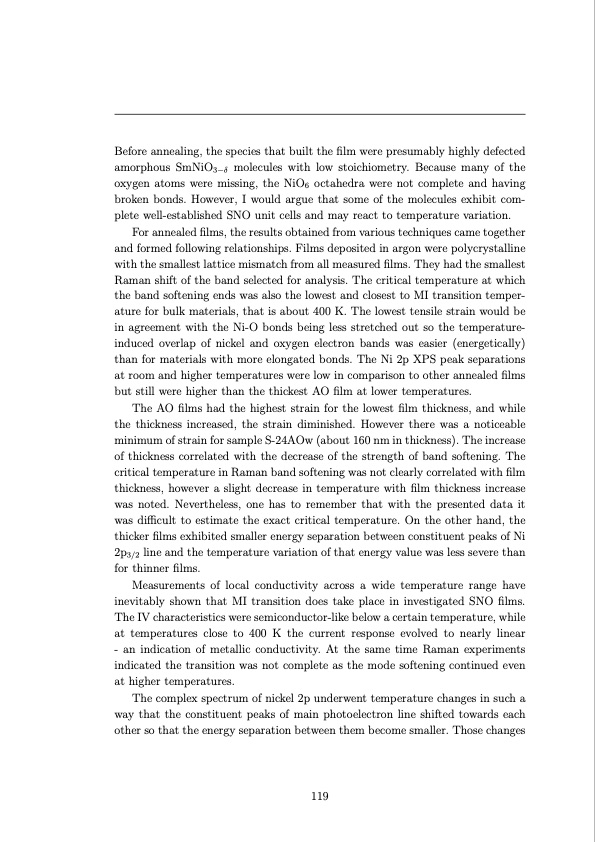
PDF Publication Title:
Text from PDF Page: 140
Before annealing, the species that built the film were presumably highly defected amorphous SmNiO3−δ molecules with low stoichiometry. Because many of the oxygen atoms were missing, the NiO6 octahedra were not complete and having broken bonds. However, I would argue that some of the molecules exhibit com- plete well-established SNO unit cells and may react to temperature variation. For annealed films, the results obtained from various techniques came together and formed following relationships. Films deposited in argon were polycrystalline with the smallest lattice mismatch from all measured films. They had the smallest Raman shift of the band selected for analysis. The critical temperature at which the band softening ends was also the lowest and closest to MI transition temper- ature for bulk materials, that is about 400 K. The lowest tensile strain would be in agreement with the Ni-O bonds being less stretched out so the temperature- induced overlap of nickel and oxygen electron bands was easier (energetically) than for materials with more elongated bonds. The Ni 2p XPS peak separations at room and higher temperatures were low in comparison to other annealed films but still were higher than the thickest AO film at lower temperatures. The AO films had the highest strain for the lowest film thickness, and while the thickness increased, the strain diminished. However there was a noticeable minimum of strain for sample S-24AOw (about 160 nm in thickness). The increase of thickness correlated with the decrease of the strength of band softening. The critical temperature in Raman band softening was not clearly correlated with film thickness, however a slight decrease in temperature with film thickness increase was noted. Nevertheless, one has to remember that with the presented data it was difficult to estimate the exact critical temperature. On the other hand, the thicker films exhibited smaller energy separation between constituent peaks of Ni 2p3/2 line and the temperature variation of that energy value was less severe than for thinner films. Measurements of local conductivity across a wide temperature range have inevitably shown that MI transition does take place in investigated SNO films. The IV characteristics were semiconductor-like below a certain temperature, while at temperatures close to 400 K the current response evolved to nearly linear - an indication of metallic conductivity. At the same time Raman experiments indicated the transition was not complete as the mode softening continued even at higher temperatures. The complex spectrum of nickel 2p underwent temperature changes in such a way that the constituent peaks of main photoelectron line shifted towards each other so that the energy separation between them become smaller. Those changes 119PDF Image | Investigation of metal-insulator transition in magnetron sputtered samarium nickelate thin films

PDF Search Title:
Investigation of metal-insulator transition in magnetron sputtered samarium nickelate thin filmsOriginal File Name Searched:
Bilewska_Investigation_of_metal_insulator_transition_in_magnetron_sputtered_samarium.pdfDIY PDF Search: Google It | Yahoo | Bing
Sulfur Deposition on Carbon Nanofibers using Supercritical CO2 Sulfur Deposition on Carbon Nanofibers using Supercritical CO2. Gamma sulfur also known as mother of pearl sulfur and nacreous sulfur... More Info
CO2 Organic Rankine Cycle Experimenter Platform The supercritical CO2 phase change system is both a heat pump and organic rankine cycle which can be used for those purposes and as a supercritical extractor for advanced subcritical and supercritical extraction technology. Uses include producing nanoparticles, precious metal CO2 extraction, lithium battery recycling, and other applications... More Info
| CONTACT TEL: 608-238-6001 Email: greg@infinityturbine.com | RSS | AMP |